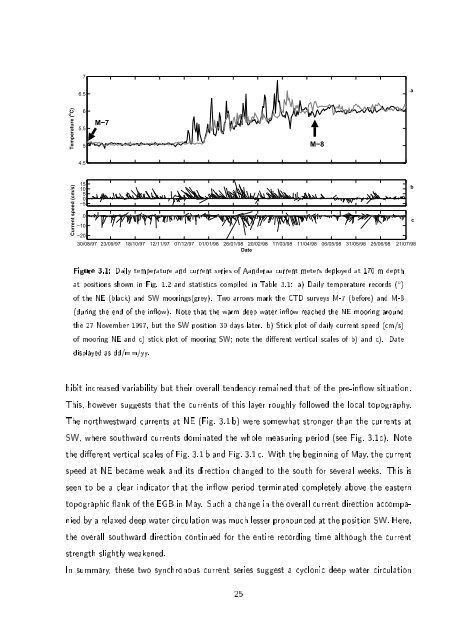Baltic Sea
Baltic Sea
Baltic Sea
Create successful ePaper yourself
Turn your PDF publications into a flip-book with our unique Google optimized e-Paper software.
7<br />
6.5<br />
a<br />
Temperature ( o C)<br />
6<br />
5.5<br />
5<br />
M−7<br />
M−8<br />
4.5<br />
Current speed (cm/s)<br />
15<br />
10<br />
−5 05<br />
0<br />
−10<br />
−20<br />
30/08/97 23/09/97 18/10/97 12/11/97 07/12/97 01/01/98 26/01/98 20/02/98 17/03/98 11/04/98 06/05/98 31/05/98 25/06/98 21/07/98<br />
Date<br />
b<br />
c<br />
Figure 3.1: Daily temperature and current series of Aanderaa current meters deployed at 170 m depth<br />
at positions shown in Fig. 1.2 and statistics compiled in Table 3.1: a) Daily temperature records ( ◦ )<br />
of the NE (black) and SW moorings(grey). Two arrows mark the CTD surveys M-7 (before) and M-8<br />
(during the end of the inow). Note that the warm deep water inow reached the NE mooring around<br />
the 27 November 1997, but the SW position 30 days later. b) Stick plot of daily current speed (cm/s)<br />
of mooring NE and c) stick plot of mooring SW; note the dierent vertical scales of b) and c). Date<br />
displayed as dd/mm/yy.<br />
hibit increased variability but their overall tendency remained that of the pre-inow situation.<br />
This, however suggests that the currents of this layer roughly followed the local topography.<br />
The northwestward currents at NE (Fig. 3.1 b) were somewhat stronger than the currents at<br />
SW, where southward currents dominated the whole measuring period (see Fig. 3.1c). Note<br />
the dierent vertical scales of Fig. 3.1 b and Fig. 3.1 c. With the beginning of May, the current<br />
speed at NE became weak and its direction changed to the south for several weeks. This is<br />
seen to be a clear indicator that the inow period terminated completely above the eastern<br />
topographic ank of the EGB in May. Such a change in the overall current direction accompanied<br />
by a relaxed deep water circulation was much lesser pronounced at the position SW. Here,<br />
the overall southward direction continued for the entire recording time although the current<br />
strength slightly weakened.<br />
In summary, these two synchronous current series suggest a cyclonic deep water circulation<br />
25



